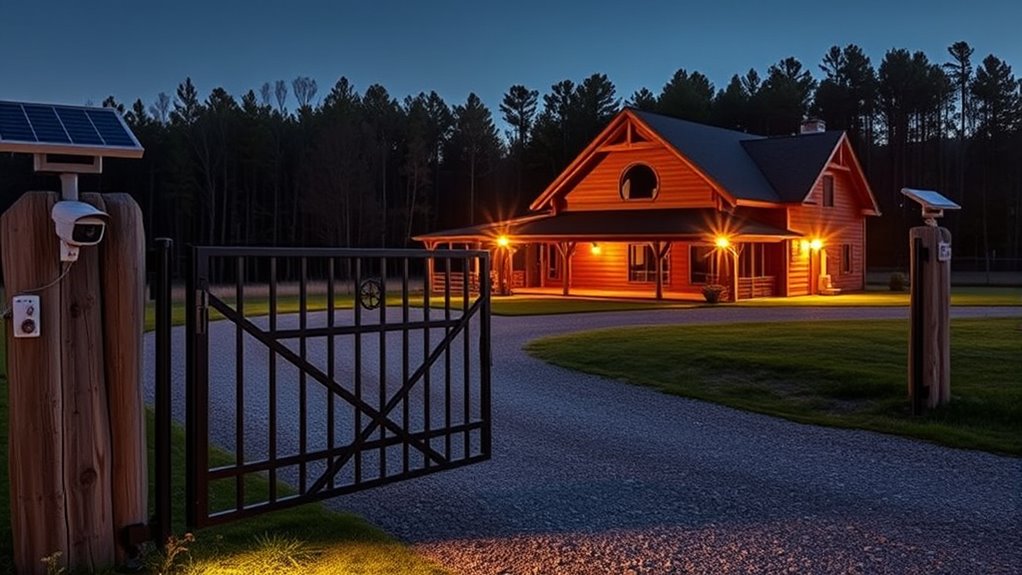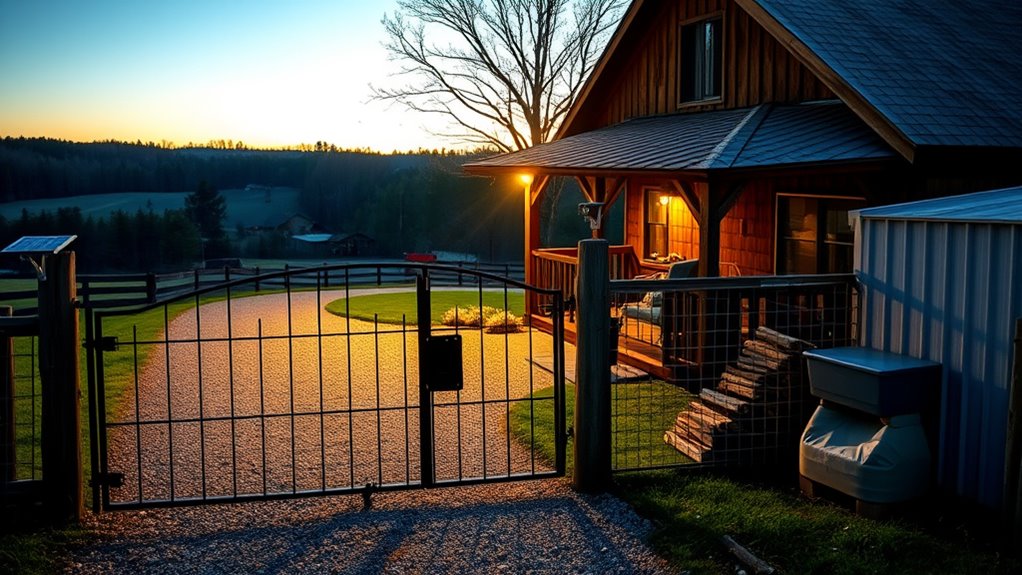To secure your rural homestead, install a smart alarm system with real-time alerts, use sturdy fencing with controlled access, and add bright, motion-activated lighting around perimeter areas. Surveillance cameras at key points provide remote monitoring and act as deterrents. Combine these elements for a layered defense that keeps intruders and wildlife out. Maintaining and upgrading your security measures regularly will help keep your property safe—discover more ways to strengthen your homestead’s protection.
Key Takeaways
- Install customizable alarm systems with real-time alerts and motion detectors for perimeter protection.
- Use high-quality fencing with secure gates and reinforce with barbed wire or electric fencing.
- Enhance visibility with bright, motion-activated lighting and strategically placed surveillance cameras.
- Integrate multiple security measures—alarms, fencing, lighting, and cameras—for comprehensive protection.
- Conduct regular maintenance and proactive planning to ensure all security features remain effective.

Living in a rural homestead offers many benefits, but it also requires proactive security measures to protect your property and loved ones. Unlike urban settings, your home might be more isolated, making it vulnerable to intruders or wildlife. To guarantee safety, you need to implement effective security strategies, starting with reliable alarm systems. Modern alarm systems can be tailored to fit your property’s size and layout, offering real-time alerts if someone tries to breach your perimeter. Wireless options are easy to install and can be connected to your smartphone, giving you peace of mind whether you’re on the property or away. Motion detectors and surveillance cameras further enhance your security, allowing you to monitor activity around your homestead remotely. These systems act as a deterrent, signaling that your property is well-protected and monitored.
Proactive security with alarm systems, fencing, and surveillance ensures rural homestead safety and peace of mind.
Alongside alarm systems, fencing techniques play a vital role in securing your homestead. A sturdy fence not only marks your property boundaries but also deters unwanted visitors. Consider using high-quality materials such as welded wire or wooden fencing, which are difficult to climb or breach. You can reinforce fences with barbed wire or electric fencing at the top to add an extra layer of security. Proper fencing also helps keep wildlife out, preventing damage to your crops and livestock. Regular maintenance is key—repair any damaged sections promptly and ensure gates are securely locked when not in use. The right fencing acts as a first line of defense, reducing the likelihood of an intrusion before other security measures come into play. Additionally, understanding aviation regulations can help you stay compliant if you plan to use drones or aircraft for perimeter monitoring, ensuring safe and legal operation. Incorporating home security systems that are compatible with remote monitoring can further enhance your ability to oversee your property from afar.
You should also think about integrating your fencing with other security features, like motion-activated lights or surveillance cameras. Bright lighting around key access points can discourage intruders and help you identify visitors or suspicious activity. Positioning cameras at entry points and along fences gives you visual confirmation of any disturbance, allowing you to respond quickly. Additionally, establishing clear pathways and keeping the perimeter clear of obstructions makes it easier to monitor your property and identify potential threats. Using reliable security equipment ensures your systems remain operational even during adverse weather conditions. For added peace of mind, consider installing backup power sources so your security systems stay functional during power outages.
In the end, securing a rural homestead isn’t about relying on a single method. It’s about creating an integrated system that combines alarm systems, effective fencing techniques, lighting, and surveillance. By taking these proactive steps, you’ll considerably reduce risks and guarantee your homestead remains a safe haven for you and your loved ones. Remember, the key to home security in a rural setting is vigilance, proper planning, and using the right tools to keep your property protected.
Frequently Asked Questions
How Can I Protect Livestock From Predators Effectively?
To protect your livestock from predators effectively, focus on strong farm animal security measures. Use sturdy fencing, such as woven wire or electric fencing, to deter predators. Keep shelters secure and well-maintained, especially at night. Install motion-activated lights and cameras to monitor activity. Regularly check for weaknesses and promptly repair any damage. By implementing these livestock predator protection strategies, you can guarantee your animals stay safe and secure.
What Are the Best Ways to Secure Remote Water Sources?
To guarantee water source protection and remote water security, start by installing sturdy fencing around your water sources. Use locks or covers to prevent contamination and unauthorized access. Consider installing surveillance cameras or motion-activated lighting to deter vandalism. Regularly inspect and maintain your water infrastructure, and keep the area clear of debris. These steps help secure your water sources, ensuring safe, reliable water for your homestead.
How Do I Set up a Silent Alarm System?
To set up a silent alarm system, you start by installing security sensors on key entry points like doors and windows. Connect these sensors to a central control panel that triggers a silent alarm when activated. Make certain the system is monitored by a security service or connected to your mobile device. This way, you get immediate alerts without alerting intruders, giving you time to respond effectively.
What Legal Considerations Exist for Home Security in Rural Areas?
Sure, because nothing says “fun weekend” like traversing legal compliance and privacy regulations. When setting up your security system, you must guarantee your surveillance respects privacy laws, avoiding eavesdropping on neighbors or public spaces. Check local laws on recording and alarm systems, and get any necessary permits. Ignoring these details might land you in hot water—or at least a hefty fine—so stay informed and keep your security legal and effective.
How Can I Deter Trespassers Without Frequent Patrols?
To deter trespassers without frequent patrols, you should leverage surveillance technology like cameras and motion sensors around your property. These tools act as effective deterrents and provide evidence if needed. Additionally, join or organize a community watch program; neighbors looking out for each other enhance security. Together, these measures create a strong, visible presence that discourages trespassing, even when you’re not actively patrolling.
Conclusion
In rural areas, home security is essential—did you know that homes in remote locations are 2.5 times more likely to be targeted? By implementing strong locks, installing surveillance, and maintaining good lighting, you can greatly reduce risks. Remember, staying vigilant and prepared keeps your homestead safer. Taking these simple steps not only protects your property but also gives you peace of mind. Stay proactive, and your rural retreat will remain secure and welcoming.










